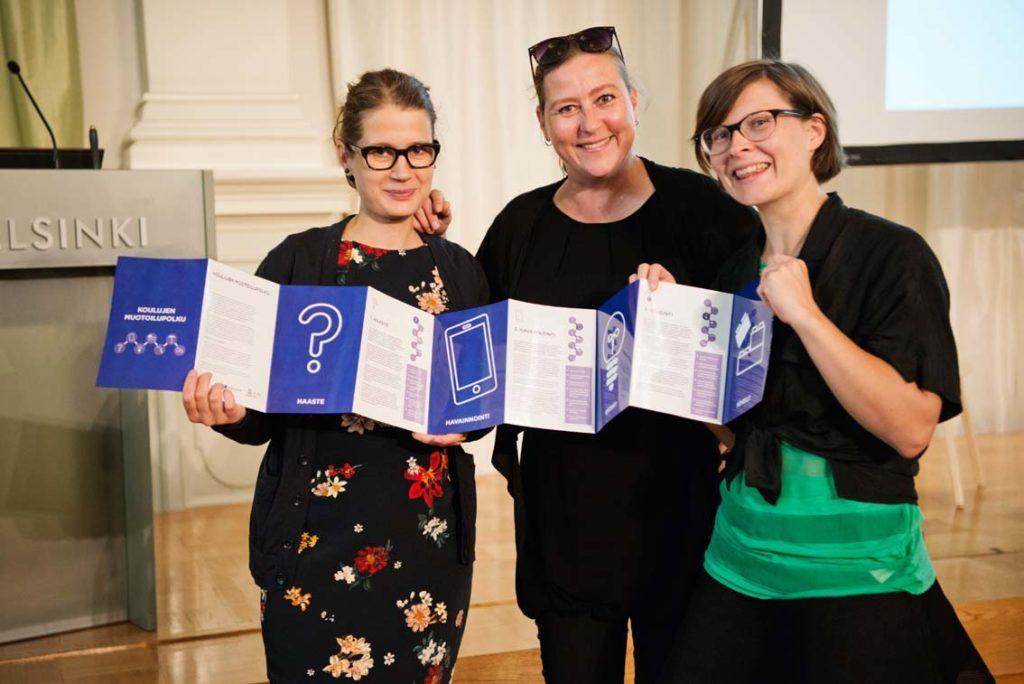Design in development of everyday school activities and education

Challenge, observation, brainstorming, experimentation, plan, implementation and evaluation. These are the phases of the Design path for schools, which was published for comprehensive schools in September. It is a tool that brings the design process closer to the schools and supports the collaborative development of the learning environment and the operational culture and the implementation of the curriculum. Using the design process, the teachers and the pupils can overcome everyday challenges together and adopt creative ways to solve problems. The Design path for schools tool can be utilised for all subjects and especially in creating a collaborative operational culture.
“Along with the new curriculum, the schools’ interest in design education has clearly increased. Design education is based on participatory and phenomenon-based learning, perspectives that are now emphasised in education. On initiative of the City of Helsinki, we participated in the assembling of the Design path for schools tool, to ensure that the teachers can find materials and complete education entities created by professionals in one place”, tells Design Expert Petra Ilonen from the Finnish Association of Designers Ornamo.
By offering the Design path for schools, the City of Helsinki wants to support the increased use of design methods at comprehensive schools. The tool has been planned for use by teachers at all 107 schools in Helsinki. It presents and gives ideas of how to apply the different phases of the design process in the school context.
Along with the new curriculum, the schools’ interest in design education has clearly increased.
The tool was tested with 100 teachers for the first time on 9 September as part of the Design Day programme at the Helsinki Design Week. The event was arranged as a collaboration between the City of Helsinki education department, The Finnish Association of Designers Ornamo, Helsinki Design Week and the HundrED project. The actors of design education have been broadly involved with the creation of the texts and contents of the Design path for schools and it has been edited by designer Pekka Toivanen from Muotohiomo Oy.

The tool was tested with 100 teachers for the first time on 9 September as part of the Design Day programme at the Helsinki Design Week. Photo: Helsingin kaupungin aineistopankki / Susa Junnola.
Design path for schools tool strengthens collaborative development
According to the new curriculum, pupils, teachers and shcool networks are increasingly important in the development of the school. Area Manager Arjariitta Heikkinen from the City of Helsinki Education Department sees the Design path for schools material as a good, new kind of tool for developing the operational culture of the school.
“It is great that the methods of the design educators have found their way to the schools. Using design, it is possible to develop many things, design is not only a tool for certain subjects. It is also of essential importance that the pupils can feel that they are truly influencing their own environment and learning”, states Heikkinen.
The design process can be applied, for example, during one lesson or it can be used for months as a way of getting to know a development object.
“Through design thinking and the design process, the schools can become inspired to work with pupils and their guardians to find solutions for the development of their own everyday environment and operational culture”, accompanies Education Consultant Kirsi Verkka.
It is great that the methods of the design educators have found their way to the schools.
Design education since the 1990’s
Architecture and design education has been part of the school operations as different kinds of projects and pilot experiments since the mid-1990’s. Design education brings process learning to the school work, where the environment is studied and the problems arising are solved.
“Design education is based on methods used by professionals: design thinking and user-centred planning. The premise of the schools lies in the pupils’ own experiences. The process features team experiments, mistakes and learning from them. A solution can be sought, for example, for school bullying or better use of the classrooms”, tells Petra Ilonen.
The Design path has been published in Opettajan kulttuurikalenteri (lit. Teachers culture calendar) at Kultus.fi.
The City of Helsinki is one of the cities that has been awarded UNESCO City of Design – status. The promotion of the use of design in schools is part of these actitivies. The strategic goals of the Finnish Government’s national Design Finland programme also encourage the inclusion of design education in early childhood education and every level of education. A goal is to increase the design understanding and competence in society.
